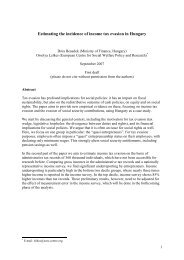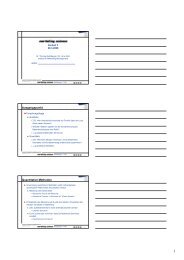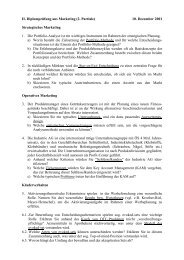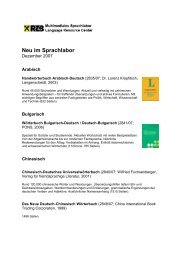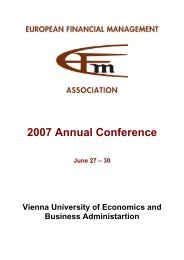Fund liquidation, self-selection and look-ahead bias in the hedge ...
Fund liquidation, self-selection and look-ahead bias in the hedge ...
Fund liquidation, self-selection and look-ahead bias in the hedge ...
Create successful ePaper yourself
Turn your PDF publications into a flip-book with our unique Google optimized e-Paper software.
Daniel <strong>and</strong> Naik, 2003, Baquero <strong>and</strong> Verbeek, 2006), this may<br />
(Agarwal,<br />
us to better identify funds that are expected to liquidate <strong>in</strong> <strong>the</strong> future<br />
allow<br />
of large negative flows after <strong>the</strong>ir report<strong>in</strong>g period). Compared<br />
(because<br />
<strong>the</strong> previous classification, 19 cases move from <strong>the</strong> <strong>self</strong>-<strong>selection</strong> to <strong>the</strong><br />
to<br />
b<strong>in</strong>.<br />
<strong>liquidation</strong><br />
<strong>the</strong> classification of cases is based on past returns, this obviously<br />
Because<br />
hassomeimpactupon<strong>the</strong>coefficientestimatesfor<strong>the</strong>laggedreturns<strong>in</strong><br />
b<strong>in</strong>ary probit models expla<strong>in</strong><strong>in</strong>g <strong>liquidation</strong> <strong>and</strong> <strong>self</strong>-<strong>selection</strong>. For <strong>the</strong><br />
<strong>the</strong><br />
model <strong>the</strong> cumulative estimated impact of past returns <strong>in</strong>creases<br />
<strong>liquidation</strong><br />
from 3.394 (Table 3) to 3.775, not tak<strong>in</strong>g <strong>in</strong>to account <strong>the</strong> underwater<br />
slightly<br />
For <strong>the</strong> <strong>self</strong>-<strong>selection</strong> model, <strong>the</strong> cumulative impact reduces from<br />
dummy.<br />
(Table 4) to 3.364. Apart from this, <strong>the</strong> estimation results for <strong>the</strong>se two<br />
4.386<br />
with <strong>and</strong> without net asset value (available upon request), are not<br />
models,<br />
different from before. Note that, even with this new classification,<br />
noticeably<br />
probability of <strong>self</strong>-<strong>selection</strong> is negatively (<strong>and</strong> statistically significantly)<br />
<strong>the</strong><br />
to past performance.<br />
related<br />
use <strong>the</strong>se new models to correct <strong>the</strong> persistence analysis for <strong>look</strong><strong>ahead</strong><br />
We<br />
<strong>bias</strong> due to <strong>liquidation</strong> <strong>and</strong> <strong>self</strong>-<strong>selection</strong>. As before, <strong>look</strong>-<strong>ahead</strong> <strong>bias</strong><br />
limited impact at <strong>the</strong> two-quarter horizon, reported <strong>in</strong> Table 7, but substantial<br />
has<br />
impact at <strong>the</strong> four-quarter horizon, reported <strong>in</strong> Table 8. Given that<br />
past returns are used to classify a case as <strong>liquidation</strong>, it is not surpris<strong>in</strong>g<br />
poor<br />
see that <strong>the</strong> <strong>bias</strong> due to fund <strong>liquidation</strong> has <strong>in</strong>creased <strong>in</strong> magnitude, at<br />
to<br />
cost of <strong>the</strong> <strong>self</strong>-<strong>selection</strong> <strong>bias</strong>. However, <strong>the</strong> expected returns for each of<br />
<strong>the</strong><br />
deciles, after correct<strong>in</strong>g for both sources of <strong>bias</strong>, are virtually <strong>the</strong> same as<br />
<strong>the</strong><br />
reported <strong>in</strong> Tables 5 <strong>and</strong> 6. To some extent this reflects <strong>the</strong> ambiguity<br />
those<br />
classify<strong>in</strong>g a case as ei<strong>the</strong>r “<strong>liquidation</strong>” or “<strong>self</strong>-<strong>selection</strong>”. Two conclu-<br />
<strong>in</strong><br />
are clear, however. First, no matter how we def<strong>in</strong>e it, <strong>self</strong>-<strong>selection</strong> has<br />
sions<br />
offsett<strong>in</strong>g impact upon <strong>the</strong> <strong>liquidation</strong> <strong>bias</strong>. Second, it is <strong>in</strong>appropriate to<br />
no<br />
correct for <strong>liquidation</strong> <strong>bias</strong> while at <strong>the</strong> same time restrict<strong>in</strong>g attention<br />
only<br />
those cases that are classified by TASS as “liquidated”.<br />
to<br />
analyz<strong>in</strong>g <strong>hedge</strong> fund performance <strong>and</strong> its persistence, a multi-period<br />
When<br />
<strong>bias</strong> or <strong>look</strong>-<strong>ahead</strong> <strong>bias</strong> may arise if funds attrite from <strong>the</strong> available<br />
sampl<strong>in</strong>g<br />
6 Conclud<strong>in</strong>g remarks<br />
databases due to reasons that relate to <strong>the</strong>ir performance. In this paper, we<br />
24



